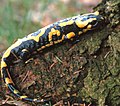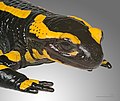
The hellbender, also known as the hellbender salamander, is a species of aquatic giant salamander endemic to the eastern and central United States. It is the largest salamander in North America. A member of the family Cryptobranchidae, the hellbender is the only extant member of the genus Cryptobranchus. Other closely related salamanders in the same family are in the genus Andrias, which contains the Japanese and Chinese giant salamanders. The hellbender, which is much larger than all other salamanders in its geographic range, employs an unusual means of respiration, and fills a particular niche—both as a predator and prey—in its ecosystem, which either it or its ancestors have occupied for around 65 million years. The species is listed as Vulnerable on the IUCN Red List of Threatened Species due to the impacts of disease and widespread habitat loss and degradation throughout much of its range.

Salamanders are a group of amphibians typically characterized by their lizard-like appearance, with slender bodies, blunt snouts, short limbs projecting at right angles to the body, and the presence of a tail in both larvae and adults. All ten extant salamander families are grouped together under the order Urodela from the group Caudata. Salamander diversity is highest in eastern North America, especially in the Appalachian Mountains; most species are found in the Holarctic realm, with some species present in the Neotropical realm.

The tiger salamander is a species of mole salamander and one of the largest terrestrial salamanders in North America.
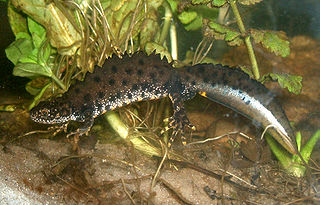
The northern crested newt, great crested newt or warty newt is a newt species native to Great Britain, northern and central continental Europe and parts of Western Siberia. It is a large newt, with females growing up to 16 cm (6.3 in) long. Its back and sides are dark brown, while the belly is yellow to orange with dark blotches. Males develop a conspicuous jagged crest on their back and tail during the breeding season.

The alpine salamander is a black salamander that can be found in the French Alps, and through the mountainous range in Europe. It is a member of the genus Salamandra. Their species name, atra, may be derived from the Latin ater, meaning dull black. The salamanders' coloration has evolved over time, as some species are completely monochrome black and others have yellow spotting and marks. Their life expectancy is at least 10 years. There are four subspecies of the alpine salamander, with varied distribution and physical coloration. Unlike other salamanders, whose larvae are developed in water, the alpine salamander and its subspecies are a fully terrestrial species in life and gestation. They give birth to live young.
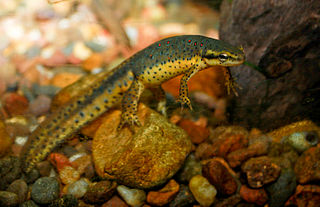
The eastern newt is a common newt of eastern North America. It frequents small lakes, ponds, and streams or nearby wet forests. The eastern newt produces tetrodotoxin, which makes the species unpalatable to predatory fish and crayfish. It has a lifespan of 12 to 15 years in the wild, and it may grow to 5 in (13 cm) in length. These animals are common aquarium pets, being either collected from the wild or sold commercially. The striking bright orange juvenile stage, which is land-dwelling, is known as a red eft. Some sources blend the general name of the species and that of the red-spotted newt subspecies into the eastern red-spotted newt.

The alpine newt is a species of newt native to continental Europe and introduced to Great Britain and New Zealand. Adults measure 7–12 cm (2.8–4.7 in) and are usually dark grey to blue on the back and sides, with an orange belly and throat. Males are more conspicuously coloured than the drab females, especially during breeding season.

The long-toed salamander is a mole salamander in the family Ambystomatidae. This species, typically 4.1–8.9 cm (1.6–3.5 in) long when mature, is characterized by its mottled black, brown, and yellow pigmentation, and its long outer fourth toe on the hind limbs. Analysis of fossil records, genetics, and biogeography suggest A. macrodactylum and A. laterale are descended from a common ancestor that gained access to the western Cordillera with the loss of the mid-continental seaway toward the Paleocene.

The California newt or orange-bellied newt, is a species of newt endemic to California, in the Western United States. Its adult length can range from 5 to 8 in. Its skin produces the potent toxin tetrodotoxin.

Batrachochytrium dendrobatidis, also known as Bd or the amphibian chytrid fungus, is a fungus that causes the disease chytridiomycosis in amphibians.

The Japanese giant salamander is a species of fully aquatic giant salamander endemic to Japan, occurring across the western portion of the main island of Honshu, with smaller populations present on Shikoku and in northern Kyushu. With a length of up to 5 feet (1.5 m), it is the third-largest salamander in the world, only being surpassed by the very similar and closely related Chinese giant salamander and the South China giant salamander.

The Sierra newt is a newt found west of the Sierra Nevada, from Shasta county to Tulare County, in California, Western North America.

The Corsican fire salamander is a species of salamander in the family Salamandridae found only on the island of Corsica as an endemic species. In former times, this species was known as a subspecies of the widespread but continental-distributed fire salamander, which may appear quite similar.

The Near Eastern fire salamander, in Arabic arouss al-ayn, is a species of salamander in the family Salamandridae found in Iran, Iraq, Turkey, Syria, Lebanon, and Israel. Its natural habitats are subtropical dry shrubland and forests, often near rivers and freshwater springs. It is threatened by habitat loss.
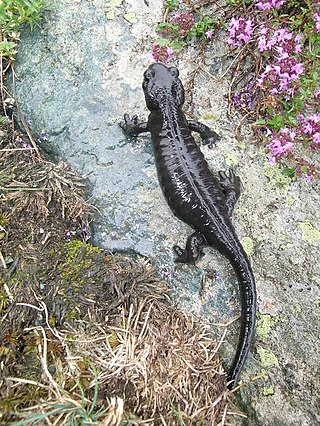
Lanza's alpine salamander or the large alpine salamander is a species of salamander in the family Salamandridae, found in France and Italy. Its natural habitats are forests, grasslands, and pasturelands, all of which are temperate. It is threatened by habitat loss and potentially in the future by the fungal disease Batrachochytrium salamandrivorans.

The Shenandoah salamander is a small, terrestrial salamander found exclusively in Shenandoah National Park in Virginia. The Shenandoah salamander inhabits a very small range of land on just three mountain peaks. Due to the small habitat range, interspecies competition, and climate change, the population of the Shenandoah salamander is vulnerable to extinction. Mitigating human effects on the habitat of the species will be essential in attempting to preserve and grow the population.
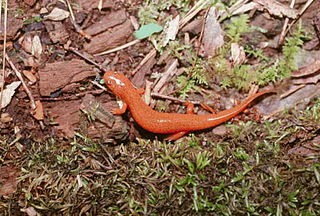
The mud salamander is a bright red salamander of the family Plethodontidae. It is found in streams, seeps and swamps and underneath logs, rocks and leaves. It is endemic to the eastern half of the United States with one isolated population in central Mississippi. Mud salamanders are rarely seen plethodontids that inhabit muddy wetland and riparian habitats. Mud salamanders don’t generally live above 700 meters in elevation in the Appalachian Mountains, resulting in two geographically isolated populations. Mud salamanders have short stocky bodies ranging from 7.5 to 16 cm long. Body color ranges with age and locality. There are four subspecies in the mud salamander complex, namely the Gulf Coast mud salamander, rusty mud salamander, Midland mud salamander and the eastern mud salamander. Mud salamanders are ectothermic, meaning that they cannot control their body temperature and it fluctuates with the temperature. The mud salamander is readily confused with two other species, the red salamander and the spring salamander.

Batrachochytrium salamandrivorans (Bsal) is a pathogenic chytrid fungus that infects amphibian species. Although salamanders and newts seem to be the most susceptible, some anuran species are also affected. Bsal has emerged recently and poses a major threat to species in Europe and North America.

Speleomantes strinatii, the French cave salamander, North-west Italian cave salamander, or Strinati's cave salamander is a small species of salamander found in northwest Italy and southeast France. It is very similar in appearance to the Italian cave salamander, but has a paler belly.
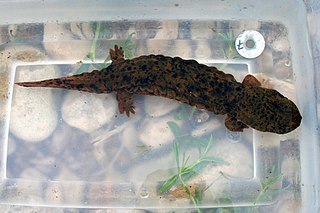
The Ozark hellbender is a subspecies of the hellbender. The subspecies is strictly native to the mountain streams of the Ozark Plateau in southern Missouri and northern Arkansas. Its nicknames include lasagna lizard and snot otter. This large salamander grows to a total length of 29–57 cm (11–22 in) over a lifespan of 30 years. The Ozark hellbender is a nocturnal predator that hides under large flat rocks and primarily consumes crayfish and small fish. As of 2011, the U.S. Fish and Wildlife Service (USFWS) has listed the subspecies as endangered under the Endangered Species Act of 1973. The population decline of the subspecies is caused by habitat destruction and modification, overutilization, disease and predation, and low reproductive rates. Conservation programs have been put in place to help protect the subspecies.





